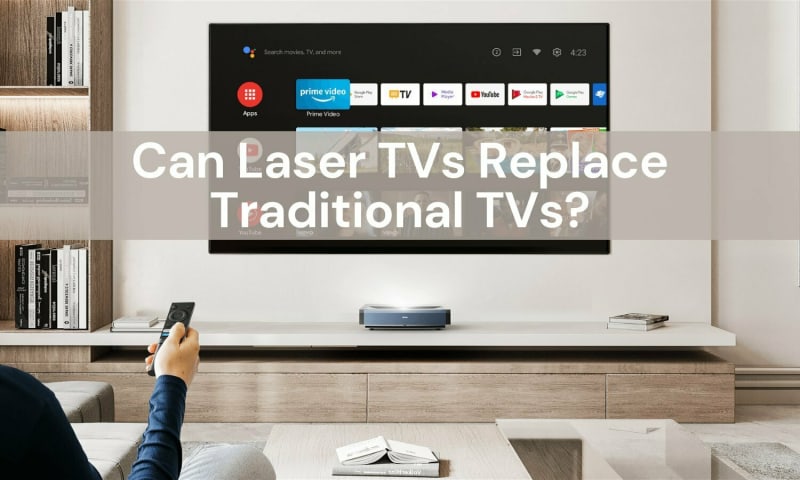
When television first appeared, people might not have imagined that square boxes of monochrome images would not only evolve into color displays, but also grow in size to fill an entire wall.
Laser TV projectors are often marketed as TV replacements because they can deliver huge images at a short distance and take up less space than any TV. It’s hard not to be intrigued by the idea of swapping a clunky big-screen TV for a small box and still getting a 100-inch (or even 150-inch) image.
Laser TVs are slowly gaining momentum as a favorite for home theater entertainment. However, the question is, can a laser TV replace third-generation TVs as the centerpiece of the living room?
What Are Laser TVs?
At a minimum, a laser TV is an ultra short throw projector powered by a laser light source, with a built-in sound system consisting of one or more speakers. With image sizes ranging from 90 to 150 inches, they’re a plug-and-play alternative to a big-screen TV — and way more affordable on an inch-by-inch basis. Why lasers? They’re far brighter and last a lot longer than conventional LEDs and high-pressure bulbs. The very best IMAX theaters use laser projectors — sometimes two at once.
Laser TVs are now within the reach of almost anyone shopping for a large TV, and they offer several advantages over their flat-panel cousins.
What Are the Advantages of Laser TVs?
Laser TVs (Like the ULTIMEA Thor T60) are changing the face of home entertainment, surpassing LED TVs. These cutting-edge devices deliver undeniable benefits:
- Adjustable screen size: By adjust the distance between the laser projector and the wall, the adjustable screen size can give you up to 150-inch viewing.
- Stunning Colour Accuracy: Laser TVs reproduce lifelike colours, offering vibrant and immersive viewing experiences.
- Deep Blacks: Offering superior depth of colour, laser TVs enhance contrast and detail.
- Energy Efficient: Reduced Power Consumption: Lasers significantly cut power use, making these TVs eco-friendly and cost-effective.
- Increased Viewing Angle: Wider Viewing Angle: Laser TVs outshine traditional LEDs by providing quality viewing from various positions.
- Excellent Cost Value: When it comes to getting more for your money, a laser TV can provide more value per square inch. You can get a much larger TV for less than you could with a traditional LED TV.
How Are Laser TVs Different from Other Types of Projectors?
Most projectors are designed to display large images on a flat surface from a distance. They are often suspended from the ceiling or placed near the back of the room, making them the home theater equivalent of commercial movie theater projection systems.
Laser TVs can achieve similarly large image sizes, but they project from a much smaller distance — usually 15 inches or less from a wall or screen.
Which Is The Best Option For You? Laser TVs or Traditional TVs?
If your priority lies in the clarity and resolution of the images, then your best buy may possibly be the OLED TV. However, if you’re interested in having the biggest screen in your living room, immersive sound and imagery, as well as the ability to bring this entertainment with you to any home and any room, then look no further than a laser TV.






Top comments (0)